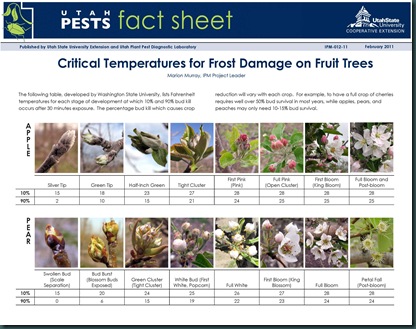Everyone likes to eat apples, including over 70 insects and a long list of fungi and bacteria. To produce good tasting, good looking fruit, we have to control those pests. Of all the flying pests, codling moth is probably the pest needing to be controlled the most. Codling moth is responsible for the proverbial worm in the apple, so to speak! As we hit 250 Degree Days in this pest's flight cycle, lets see how we might control it.
Codling moth is a small moth whose caterpillars bore into the fruits of apple and pear trees during mid- to late-summer. Codling moth is the cause of what is often referred to as "the proverbial worm in the apple". The caterpillars of this insect can damage a high proportion of the fruits on apple trees in gardens in a small amount of time.
Codling moth is a small moth whose caterpillars bore into the fruits of apple and pear trees during mid- to late-summer. Codling moth is the cause of what is often referred to as "the proverbial worm in the apple". The caterpillars of this insect can damage a high proportion of the fruits on apple trees in gardens in a small amount of time.
 |
| Codling Moth Larvae |
The eggs, larvae and pupae of codling moth each have specific physiological time requirements to complete development before they transform to the next stage. Temperature also affects the flight, mating and egg laying activities of the adults. Although the minimum threshold for emergence of moths is 50 degrees Fahrenheit, male moths do not fly until temperatures exceed 55.4 degrees F and codling moths do not mate until temperatures exceed 60.8 degrees F.
To determine when flight begins for codling moth, commercial growers make use of pheromone traps. Once moths have been trapped for two consecutive days in a row, a biofix is set that initiates the beginning of growing-degree-day calculations. We know that at 100 degree days after the biofix date codling moths begin to lay eggs and those eggs begin to hatch at 250 degree days after biofix. It is this information that aids in the timing of necessary sprays for codling moth so they do not damage fruit. Growers wishing to time sprays based on egg development and hatch should make an application of an insecticide at 250 DD (base 50 degrees F) after the first sustained capture of males in the sex pheromone traps. Here is a Detailed Growing Degree Day Model for Codling Moth.
For the home orchardist who does not have the benefit of a weather station or other means to calculate degree days, a simple tree growth stage time table can be followed. Codling moths usually start flying at bloom time. Eggs laid by these moths begin to hatch about two weeks after petal fall, depending on the weather. You can apply the first codling moth spray at this time to prevent larvae from entering the fruit. Because insecticide residues last 7 to 10 days and moths are continuously present throughout the summer, apply a spray every 7 to 10 days to prevent later broods of codling moth larvae from entering apple and pear fruits. Always follow the label directions of any spray you may use.
Several insecticides can be used for codling moth control including acetmaprid and/or spinosad. Acetamiprid is a soft, conventional control and is available as Ortho Flower, Fruit & Vegetable Insect Killer. This is a ready to use product that contains .006% acetamiprid, a synthetic organic compound of the family of chemicals that acts as neonicotinoid insecticides. Acetamiprid is a contact insecticide for sucking-type insects and can be applied as a foliar spray or a soil treatment. Acetamiprid acts on a broad spectrum of insects, including aphids, thrips, plum curculio, apple maggot and Lepidoptera, especially codling moth. When sprayed in the evening at sunset, it will not harm bees or other beneficial insects. Be sure to follow all label directions on the bottle for proper application.
 An all natural approach is available in the form of Bonide’s Captain Jack’s Dead Bug Brew. Captain Jack's Deadbug Brew® contains Spinosad (spin-OH-sid), a product first isolated from a naturally occurring soil dwelling bacterium that was collected on a Caribbean island from an abandoned rum distillery. Deadbug Brew® kills bagworms, borers, beetles, caterpillars, codling moth, gypsy moth, loopers, leaf miners, spider mites, tent caterpillars, thrips and more! Use on fruits, vegetables, berries, citrus, grapes, nuts and ornamentals and approved for organic gardening.
An all natural approach is available in the form of Bonide’s Captain Jack’s Dead Bug Brew. Captain Jack's Deadbug Brew® contains Spinosad (spin-OH-sid), a product first isolated from a naturally occurring soil dwelling bacterium that was collected on a Caribbean island from an abandoned rum distillery. Deadbug Brew® kills bagworms, borers, beetles, caterpillars, codling moth, gypsy moth, loopers, leaf miners, spider mites, tent caterpillars, thrips and more! Use on fruits, vegetables, berries, citrus, grapes, nuts and ornamentals and approved for organic gardening.For additional information, see the following fact sheets which are available from local university extension services:











